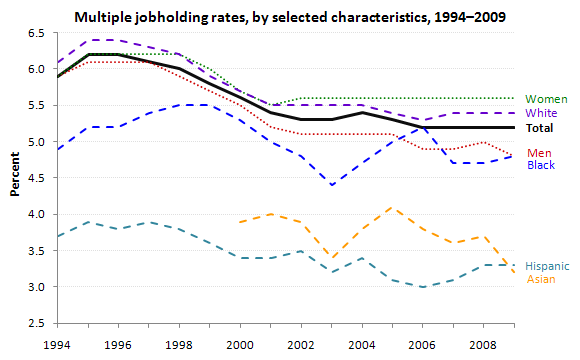In 2009, the multiple jobholding rate—the proportion of total employment made up of workers who held more than one job—was 5.2 percent, below the levels recorded during the mid-1990s. Among most of the major demographic groups, "moonlighting" has become less common in recent years compared with the mid-to-late 1990s.
The multiple jobholding rate reached its most recent peak (6.2 percent) during 1995–96. The rate began to recede and declined to 5.3 percent by 2002. From 2003 to 2007, the multiple jobholding rate held steady and never returned to its high. Since the start of the most recent recession in December 2007, the multiple jobholding rate has hovered around 5 percent.
Multiple jobholding rates for most of the major demographic groups—men, women, Whites and Blacks—have exhibited a similar pattern over the 1994–2009 period.
During the 1990s and early 2000s, the multiple jobholding rates of men and women were similar, but since 2002, the gap in rates between men and women has widened as men have worked multiple jobs at a lower rate than women have. In 2009, the multiple jobholding rate for women (5.6 percent) was higher than that for men (4.8 percent).
Among the major race and ethnic groups, Whites were most likely to hold more than one job. In 2009, the multiple jobholding rate for Whites was 5.4 percent, while the rates for Blacks and Hispanics were 4.8 percent and 3.3 percent, respectively. The rate for Asians was 3.2 percent.
This data is from the Current Population Survey program. To learn more, see "Multiple jobholding during the 2000s" (PDF), in the Monthly Labor Review, July 2010. Multiple jobholders are those persons who report that they are wage or salary workers who hold two or more jobs, self-employed workers who also hold a wage or salary job, or unpaid family workers who also hold a wage or salary job.





